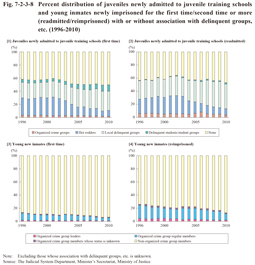6 Association with delinquent groups
Fig. 7-2-3-8 shows the percent distribution of juveniles newly admitted to juvenile training schools and young inmates newly imprisoned for the first time/second time or more who were or were not associated with delinquent groups or organized crime groups since 1996.
The proportion of juveniles newly admitted to juvenile training schools who were associated with local delinquent groups was high, with this trend being particularly remarkable with those readmitted in 2010. In addition, the proportion of those associated with delinquent students/student groups and hot rodders was high with those admitted for the first time, and those associated with hot rodders was high with those readmitted. The proportion of those associated with organized crime groups was not high but was higher with those readmitted than with those admitted for the first time. Examining changes in the percent distribution since 1996 revealed that the proportion of those associated with local delinquent groups was rising from 2004 with both those admitted for the first time and those readmitted, while the proportion of those associated with hot rodders was declining from 2002 or 2003. In addition, the proportion of those associated with delinquent students/student groups was rising from 2003 with those admitted for the first time.
With young new inmates the proportion of those who belonged to organized crime groups was declining from 1996 with both young inmates newly imprisoned for the first time and those reimprisoned, but was higher with those reimprisoned than with those imprisoned for the first time. In 2010 it was 6.4% with young new inmates imprisoned for the first time and 13.0% with those reimprisoned (See Fig. 4-2-3-2 for the number of new inmates associated with organized crime groups).
Fig. 7-2-3-8 Percent distribution of juveniles newly admitted to juvenile training schools and young inmates newly imprisoned for the first time/second time or more (readmitted/reimprisoned) with or without association with delinquent groups, etc. (1996-2010)
